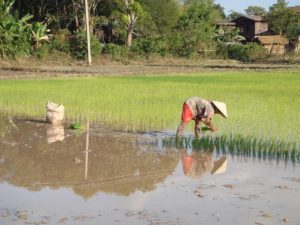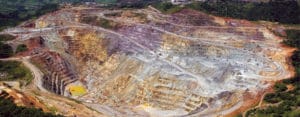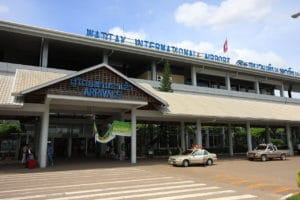Subsistence agriculture still accounts for half of the GDP and provides 80 percent of employment. Only 4.01 percent of the country is arable land, and a mere 0.34 percent used as permanent crop land, the lowest percentage in the Greater Mekong Subregion. The irrigated areas under cultivation account for only 28% of the total area under cultivation which, in turn, represents only 12% of all of the agricultural land in 2012. Rice dominates agriculture, with about 80 percent of the arable land area used for growing rice. Approximately 77 percent of Lao farm households are self-sufficient in rice.

Through the development, release and widespread adoption of improved rice varieties, and through economic reforms, production has increased by an annual rate of five percent between 1990 and 2005, and Lao PDR achieved a net balance of rice imports and exports for the first time in 1999. Lao PDR may have the greatest number of rice varieties in the Greater Mekong Subregion. Since 1995 the Lao government has been working with the International Rice Research Institute of the Philippines to collect seed samples of each of the thousands of rice varieties found in Laos.
The economy receives development aid from the IMF, ADB, and other international sources; and also foreign direct investment for development of the society, industry, hydropower and mining (most notably of copper and gold). Tourism is the fastest-growing industry in the country. Economic development in Laos has been hampered by brain drain, with a skilled emigration rate of 37.4 percent in 2000.
Laos is rich in mineral resources and imports petroleum and gas. Metallurgy is an important industry, and the government hopes to attract foreign investment to develop the substantial deposits of coal, gold, bauxite, tin, copper, and other valuable metals. In addition, the country’s plentiful water resources and mountainous terrain enable it to produce and export large quantities of hydroelectric energy. Of the potential capacity of approximately 18,000 megawatts, around 8,000 megawatts have been committed for exporting to Thailand and Vietnam.

The country’s most widely recognized product may well be Beerlao, which in 2017 was exported to more than 20 countries worldwide. It is produced by the Lao Brewery Company.
The mining industry of Laos has received prominent attention with foreign direct investments. This sector, since 2003–04, has made significant contributions to the economic condition of Laos. More than 540 mineral deposits of gold, copper, zinc, lead and other minerals have been identified, explored and mined.
Transportation:
The main international airports are Vientiane’s Wattay International Airport and Luang Prabang International Airport with Pakse International Airport also having a few international flights. The national carrier is Lao Airlines. Other carriers serving the country include Bangkok Airways, Vietnam Airlines, AirAsia, Thai Airways International, China Eastern Airlines and Silk Air.

Much of Laos lacks adequate infrastructure. Laos has no railways, except a short link to connect Vientiane with Thailand over the Thai–Lao Friendship Bridge.
